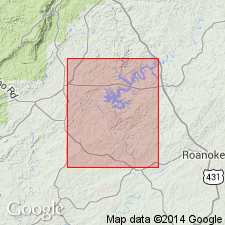
- Usage in publication:
-
- Cornhouse Schist
- Modifications:
-
- Named
- Dominant lithology:
-
- Schist
- Phyllite
- AAPG geologic province:
-
- Piedmont-Blue Ridge province
Summary:
Cornhouse Schist is here formally named for exposures along Cornhouse Creek. This distinctive rock sequence represents lower units of the Cragford Phyllite that have been affected by late metamorphic and tectonic activity. Sequence is characterized by intermediate to high metamorphic grade and a strong secondary foliation. The Cornhouse is a medium- to coarse-grained multiply foliated and complexly deformed rock consisting predominantly of muscovite-biotite-quartz-plagioclase schist with accessory minerals of chlorite, biotite, kyanite, staurolite, and garnet. Quartz content ranges from 5 to 30 percent. Metamorphic grade of the matrix ranges from upper staurolite subfacies to upper kyanite subfacies. Much of the Cornhouse is stratigraphically equivalent to the Cragford Phyllite and is separated from it by a broad metamorphic gradient involving gradational textures and mineralogy. The contact between the two has been defined as the point at which the late schistose textures are the predominant rock fabric. Age on plate 1 shown as Precambrian to late Paleozoic.
Source: GNU records (USGS DDS-6; Reston GNULEX).

- Usage in publication:
-
- Cornhouse Schist
- Modifications:
-
- Overview
- AAPG geologic province:
-
- Piedmont-Blue Ridge province
Summary:
Cornhouse Schist of Wedowee Group is medium- to coarse-grained, multiply foliated +/-plagioclase +/-garnet-biotite-muscovite-quartz schist interlayered with chlorite-biotite-garnet schist; locally contains feldspathic quartzites, muscovite schists, and thin layered amphibolites. Typically mylonitic in texture and commonly contains "spindles", "buttons", or small lenticular disks of graphite-sericite phyllite. Found in northern Piedmont. Age is Precambrian to Paleozoic (as shown on plate; age appears to be generalized).
Source: GNU records (USGS DDS-6; Reston GNULEX).
For more information, please contact Nancy Stamm, Geologic Names Committee Secretary.
Asterisk (*) indicates published by U.S. Geological Survey authors.
"No current usage" (†) implies that a name has been abandoned or has fallen into disuse. Former usage and, if known, replacement name given in parentheses ( ).
Slash (/) indicates name conflicts with nomenclatural guidelines (CSN, 1933; ACSN, 1961, 1970; NACSN, 1983, 2005, 2021). May be explained within brackets ([ ]).

